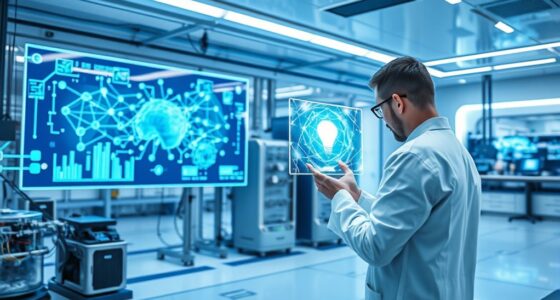Lifelike humanoid robots now showcase remarkably human-like facial expressions thanks to advanced facial recognition and muscle actuation technologies. They analyze subtle cues like eye tension, eyebrow movement, and mouth shape to mimic emotions such as joy, sadness, or curiosity with uncanny accuracy. These realistic expressions help reduce the uncanny valley effect and make interactions more natural and engaging. If you keep exploring, you’ll discover how these innovations are transforming how robots connect with people every day.
Key Takeaways
- Advanced facial recognition analyzes human expressions to enable robots to mimic subtle emotional cues accurately.
- Precise facial muscle adjustments create natural, dynamic expressions that enhance realism and emotional connection.
- The technology reduces the uncanny valley effect by making facial movements more lifelike and relatable.
- Robots can interpret human emotions in real time, allowing authentic responses in social interactions.
- These developments improve human-robot interactions, making robots appear more human-like and emotionally intelligent.

Have you ever wondered how humanoid robots can show emotions through their faces? It’s a fascinating blend of technology and psychology. The secret lies in the development of robotic emotion, which enables robots to mimic human feelings convincingly. Engineers and researchers have made significant strides in creating facial expressions that seem almost alive, thanks to sophisticated systems that analyze and replicate emotional cues. At the core of this advancement is facial recognition technology, which allows the robot to interpret human expressions and respond in kind. This interactive process creates a more natural, engaging experience, making it feel as if the robot truly understands your mood.
Humanoid robots mimic human emotions using facial recognition and expressive technology for more natural interactions.
Facial recognition isn’t just about identifying who is in front of the robot; it’s also about understanding what that person feels. When you approach a humanoid robot, it scans your face, analyzing subtle cues like the shape of your mouth, the movement of your eyebrows, and the tension in your eyes. These cues provide critical information about your emotional state. The robot then processes this data with complex algorithms that assign emotional values, enabling it to generate a suitable facial expression. Whether you’re smiling, frowning, or showing surprise, the robot’s ability to recognize and interpret these signals makes its reactions seem genuine.
The development of robotic emotion involves more than just mimicking static expressions. These robots can display a range of human-like emotions, from joy and sadness to confusion and curiosity. They do this by adjusting their facial muscles with precision, thanks to a network of actuators and motors designed to replicate human facial movements. The key is in the subtlety—tiny movements that convey complex emotional states. The result is a face that dynamically shifts in a way that feels natural, reducing the uncanny valley effect and enhancing the sense of connection between humans and robots. Additionally, advancements in facial recognition technology have significantly contributed to improving these emotional displays by enabling more accurate interpretation of human cues.
This technology isn’t solely for show; it plays a vital role in applications like healthcare, customer service, and companionship. When a robot can recognize facial expressions and respond with appropriate emotions, interactions become more meaningful and empathetic. You might notice how a humanoid robot can comfort someone feeling sad or celebrate with someone who’s happy. By integrating facial recognition with robotic emotion, these machines are edging closer to genuine human-like social interactions, making them more effective and relatable. It’s a remarkable leap forward in creating robots that don’t just look human but also feel human in their expressions.
Frequently Asked Questions
Can the Robot Experience Genuine Emotions?
You might wonder if the robot can truly feel emotions. While it can mimic emotional authenticity and simulate empathy through facial expressions and responses, it doesn’t genuinely experience feelings like humans do. Instead, it processes data to create convincing reactions. So, although it appears emotionally authentic and can simulate empathy effectively, the robot’s responses are programmed, not rooted in genuine emotional experience.
How Long Does It Take to Develop Such Realistic Expressions?
You might wonder how long it takes to develop realistic expressions in robots. Some experts believe that mastering robotic facial cues and emotional simulation can take years of research and fine-tuning. Achieving natural, human-like gestures involves complex programming and advanced sensors, allowing the robot to mimic genuine emotions. While progress is rapid, creating truly lifelike expressions remains a challenging task that requires ongoing innovation and detailed understanding of human facial dynamics.
Is the Robot Capable of Understanding Human Emotions?
You’re curious if the robot understands human emotions. While it can recognize facial expressions through advanced facial recognition technology, it doesn’t possess emotional intelligence like humans. It responds based on programmed algorithms, mimicking understanding without true feelings. So, although it may seem empathetic, it doesn’t genuinely comprehend emotions; it simply processes visual cues to generate appropriate reactions, giving the illusion of understanding human feelings.
What Are the Ethical Implications of Lifelike Robots?
Imagine a robot with human-like eyes that seem to hold emotions. You might wonder if it deserves rights or if its expressions are authentic. The ethical implications are complex; you must consider robot rights and whether these machines truly experience emotions or just mimic them. Balancing innovation with moral responsibility is key, ensuring you treat these lifelike creations with respect, recognizing their potential impact on human relationships and societal norms.
Will This Technology Replace Human Interaction in the Future?
You might wonder if robotic companionship will replace human interaction someday. While these lifelike robots can mimic emotional authenticity and provide comfort, they can’t fully replicate genuine human connection. Technology advances may enhance companionship, but it’s unlikely to replace the deep empathy and understanding only humans can offer. So, you’ll still value real relationships, even as you interact more with emotionally expressive robots that complement your social experiences.
Conclusion
You might be surprised to learn that over 90% of people find humanoid robots with realistic facial expressions almost indistinguishable from humans. This incredible advancement brings us closer to seamless human-robot interactions, making daily tasks more efficient and engaging. As these robots continue to improve, you’ll see them playing essential roles in healthcare, customer service, and companionship. It’s exciting to imagine a future where these lifelike machines become an everyday part of your life.









